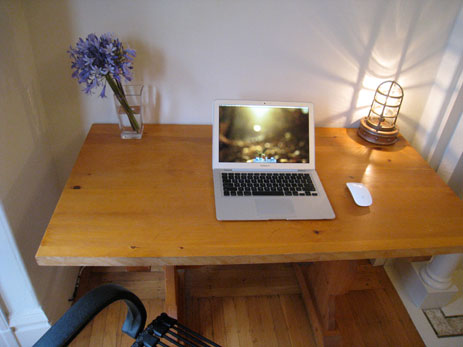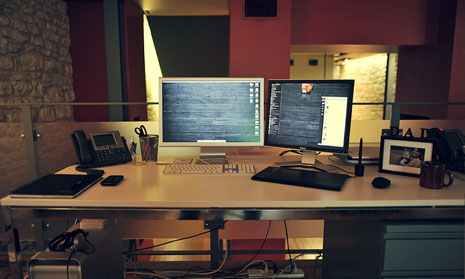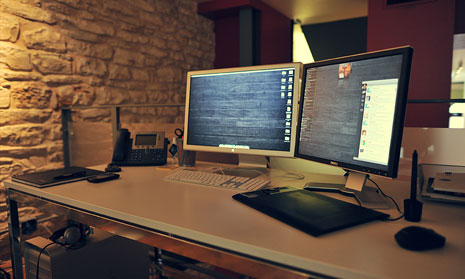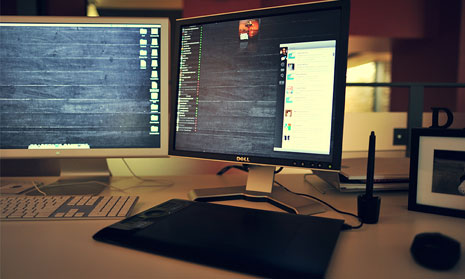Who are you, what do you do, and etc…?
My name is John Carey. I am a photographer moonlighting as a live audio engineer or the other way around depending on what day you ask me. I also run the website fiftyfootshadows.net on which I provide many images from my photographic work as wallpaper imagery for my readers. I have done this for somewhere around seven or eight years now and I feel it is just starting to pick up momentum. There is a significant update to the site currently under construction which I hope will help it grow beyond where I have taken it to this point, but more on that when the time comes…
I started out with drive to become a designer, but over time my desires shifted toward photography. I love the honest nature of it, the compromises within it, and the fact that I can bridge a very tangible art form using traditional film cameras with a highly digital one using digital cameras and computers to create images and share the world as I see it with others. I have grown very passionate for the art of photography and the places it takes me, and I am anxious to see where I end up with it next.
My secret double life as a live audio engineer is equally fulfilling and rewards me with the same sort of satisfaction photography does in the way that I am using both analog tools as well as digital ones to get the job done. I love my work and often wonder if I could live without either of these sides of my professional life because they fulfill my lust for adventure in such unique ways.
What is your current setup?
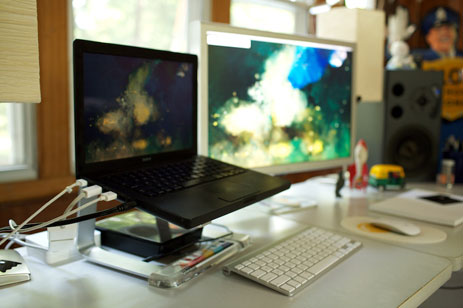
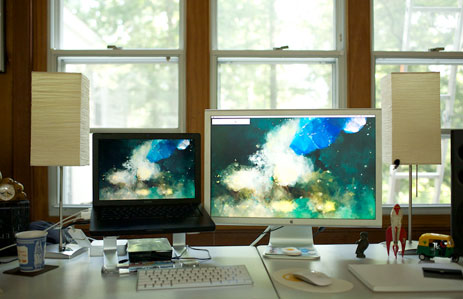
I have been a Mac user my entire life. Honestly, I have been using them since the Apple II days and every iteration they have come out with along the way. I remember shooting with an old Apple Quicktake digital camera along side an old film Canon when I was just starting to get into photography and design. I followed the digital photography revolution very closely as it crept into the minds of skeptical photographers.
My current set up is simple and built from a combination of necessity, luck, and (like any self-respecting geek) an unhealthy desire for new tech.
That said I currently have an old black MacBook which at home is paired with a Cinema Display, bluetooth keyboard, Magic Mouse, Griffin laptop stand, 8 or more hard drives, and a pair of powered studio monitors because I simply need a nice pair of speakers around for my sanity. I also use a 64GB Wi-Fi iPad, and a 32GB iPhone 4.
If anyone is interested in what I shoot with, I use a Canon 5D paired simply with a 35mm f/1.4L lens, a Hasselblad 501cm with its standard 80mm lens, and a Voigtlander R3M 35mm rangefinder with a 40mm f/1.4 Nokton Lens.
Why this rig?
The core of what I use revolves around the MacBook, the last generation of the black plastic bodied ones. At the time it was the top of the line and it has proven itself to be more than capable through its years of use and certainly the most stable and dependable Mac I have ever owned. I will admit that it’s probably seeing its last good year in use and may need to be replaced sooner or later simply to keep up with newer tech and the demands of the work I do.
But the question is WHY. Yes… well, the true nature of my life is pretty nomadic as I am constantly on the move either traveling for work or traveling for pleasure around the world whenever possible. My office is anywhere and everywhere it needs to be so my portable tools are as important to me as the modest space I have at home for computing. My real office is carried in bags with me wherever I go, at times two or three even. I always have my cameras with me, if not all of them at least one, and I usually carry my laptop for work but also simply out of necessity because much of my blogging and internet life I squeeze into down time at work or while traveling and so I often need to have these key things with me wherever I go.
Also I have a small bunch of tools that I always carry for work, as well as a blank notebook or two and a couple nice pens (because nothing beats pen and paper for sketching out ideas, no matter how many apps you have for it) and other sorts of little things depending on what I need on any given day.
My bags of choice are made by an amazing bag company called Spire. I swear by them and their amazing customer service — you really can’t go wrong with those guys. I’m looking forward to seeing what they come up with next, their bags have traveled the world with me.
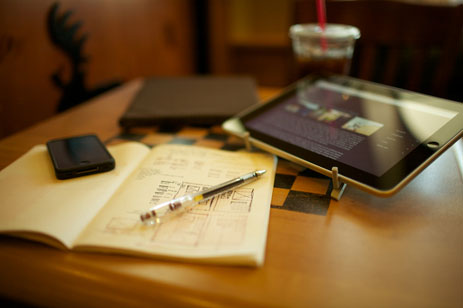
When I do set up office away from home I have my iPad to handle more and more of my day-to-day internet shuffle, and I will have to admit at this point the 3G option sure would have been nice at times. It has allowed me to leave the laptop at home more often which is nice. I use a wonderful little stand, the Compass, and it has been more than helpful in giving my iPad a home while out on the job or in a coffee shop working on ideas.
To protect the iPad while out I use a simple fabric sleeve I had a friend make for me to my specifications including a thin piece of wood to protect the screen which was sewn into the fabric and padding. (I actually do this to my laptop bag as well, a worthwhile customization for anyone wanting to really protect their screen.) I also have a Speck candyshell case for it which I use while I am on job sites to keep it safe.
The last piece of the puzzle is my iPhone 4 which I admit I bought into because of the camera and display. Its a wonderful device and the controversy surrounding is just way out of control. It’s a brilliant phone plain and simple, and it holds all the little things in my life together.
What software do you use and for what do you use it?
My favorite applications on the Mac which I use most often are:
- Aperture: I love Adobe’s take on raw photo management as well as Lightroom being faster overall in its performance, but I greatly prefer the workflow of Aperture — both in file management and editing. I find it is easily worth the compromise.
- Photoshop: It’s just unavoidable in my photo and occasional design work really. I have been using it since version 3, just before layers came on board and changed everything. My use of the program is admittedly very minimal as I have long since moved beyond my days of over manipulating images (it just got old after a while).
- Illustrator: I have been using Illustrator for what seems like forever as well. I remember messing about with it when I was very young, making overly complex blends between objects that the poor old computer running it at the time took forever to render. I use it for layout mostly — this and many other design needs. It’s just as relevant to me as Photoshop really.
- CSSEdit: I love working with websites. I have been making them since the late ’90s to share my design and photography, but the problem is I never REALLY learned how to do it. My knowledge of making websites has been pieced together out of necessity. And I learn as I go, so an application like CSSEdit that helps me simplify editing style sheets is a wonderful thing indeed.
- Espresso: Any HTML or PHP editing I have to do I reach for Espresso simply because I love its approach to interface design. Simply brilliant.
- Things: Again with the interface design. I looked for years to find an elegant solution to handle my task list and notes, and this hit the nail on the head. It’s the glue that holds my ideas and projects and jobs together. Now if they would just hurry up and get cloud syncing in there!
- MarsEdit: The newest member of the family. MacJournal was my go-to, local blogging tool for a long time, but it started to get frustrating with its half-way support for uploading. So I made the switch that was a long time coming.
- The rest: Then there are all the other in-betweens. iTunes, CoverSutra, DropBox, DeskShade, Safari, Mail, Transmit, and not to mention the iPad and iPhone apps that have made their way into key parts of my workflow. I also create electronic-fueled music with a good friend of mine and have for years. And for that I use Reason and Ableton Live, whereas he uses countless other applications as he is more the musician that lives and breathes electronic music.
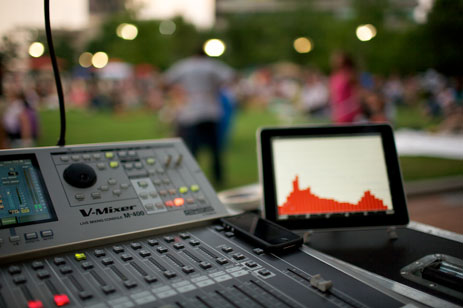
How does this setup help you do your best creative work?
Well, as I mentioned, my life is always on the move and these tools allow me to easily and elegantly glide between tools needed to accomplish the many projects I juggle at any given moment. It can be stressful trying to do so much at once and being able to quickly and confidently jump between tasks allows me to focus less on messing about with my computer and focus more on simply getting things done. For me the tech I use should actually make my life easier to manage, not get in the way of the process. I am not a super geek by any stretch of the imagination, I just learn the tools I need to know to accomplish what I want to.
It’s amazing the amount of mileage I have gotten out of this simple old MacBook over the years. It’s not always necessary to constantly have the latest and greatest unless you really have a need to. I do my best to stay relevant in this unbelievably demanding world we live in, but most of the time less is defiantly more.
How would your ideal setup look and function?
My money-is-no-object, ideal setup would be a large 27″ iMac at home for all my heavy lifting and data management, then a MacBook Air for travel. Only I want one that Apple has yet to make — one slightly more capable, and who knows if that will ever see the light of day. This paired with an iPad for presentations and casual use and my iPhone simply because it easily syncs information together with the rest of Apple’s universe.
The last addition would be a hefty RAID Server for hard drive/data management. It’s exhausting having to juggle all of these hard drives!
Also, an oversized desk with plenty of workspace would be nice. One that I could build a light table into. I like the idea of having a lot of extra space… breathing room for my mind.
More Sweet Setups
John’s setup is just one in a series of sweet Mac Setups.
